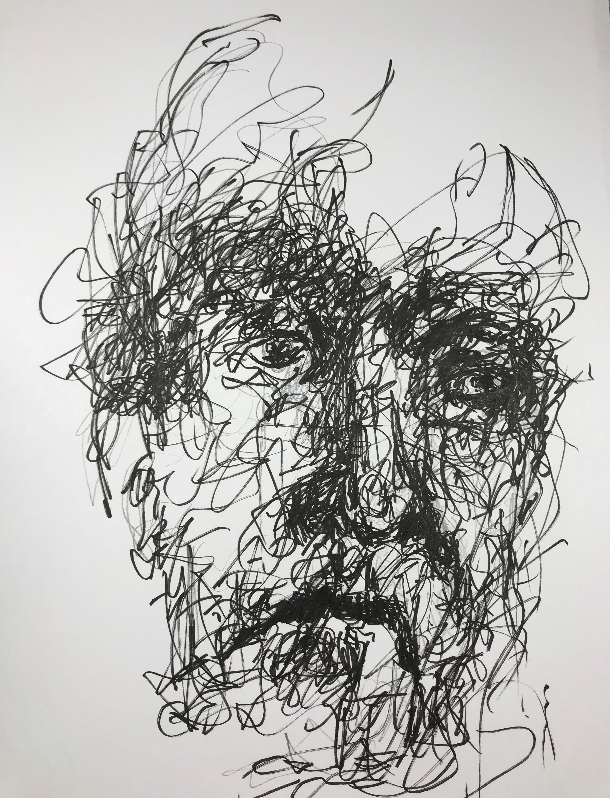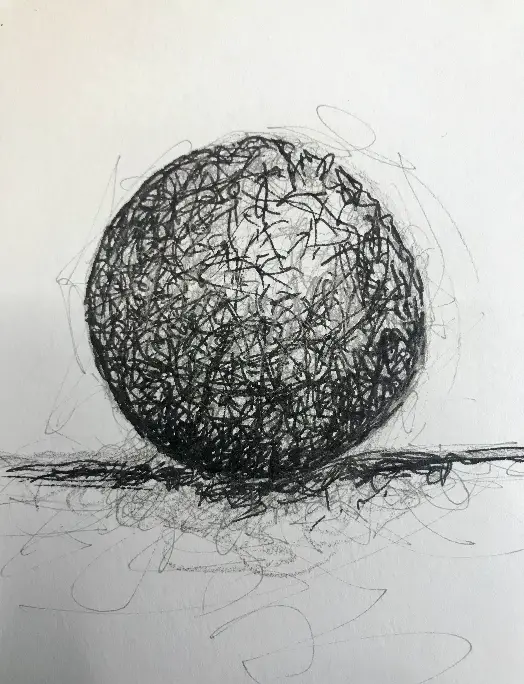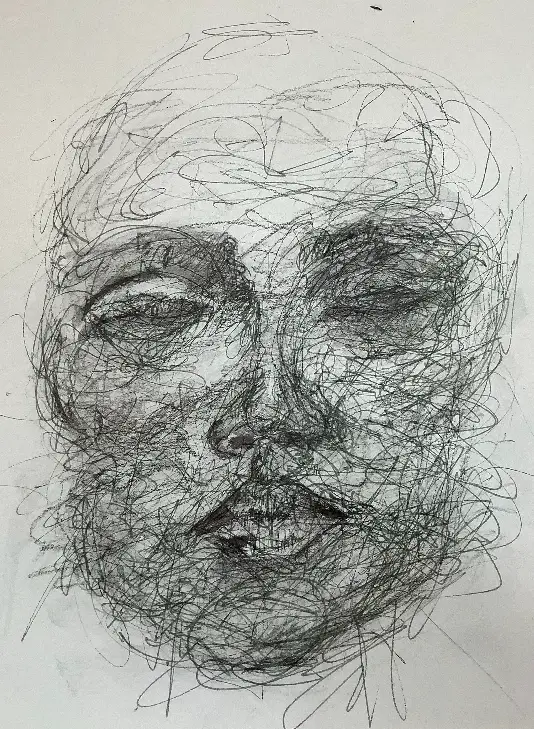What is Scribble Art?
If scribble drawing sounds interesting to you, you should take the time to learn about how it is done and what types of paths you can pursue when working on a drawing. Despite its name, scribble drawing is not a simple, haphazard form of creating artwork.
While it's true that scribble drawing should be done quickly and fluidly, that doesn't mean that you shouldn't spend time planning out composition, figuring out light sources, and considering perspective.
All of the processes you use for a more traditional type of artwork apply, but the rules should be a bit looser. If you're trying to use the spontaneity of scribble drawing to your advantage, plan out your drawing quickly, then jump right into it. You shouldn't spend time on an underdrawing, you should jump right into the final drawing, less you lose one of the main positive attributes of this art style.
Related Posts:
What is Scribble Drawing Called?
Scribble drawing is known by many names. It is sometimes called doodling, gesture drawing, or scribbling. These names apply to the same general principle, creating artwork quickly and loosely.
Scribble drawing should convey both the image you portray and the feeling you are trying to evoke. The quick lines that you use shouldn't give rise to a feeling of motion and energy, making your messy drawing lively and exciting for the viewer to look at.
How do you Make a Scribble Drawing?
Scribble drawing is the most natural way to create art and a method for creating art that might feel totally foreign to you. Try to think of it this way, the first art you created, when writing was still new to you, was probably done with crayons.
Those scribbles eventually gave way to forming shapes and telling stories, evolving into whatever unique art style that you employ today. The trick to mastering scribble drawing is to take a step backward.
You want to embrace the more chaotic approach you had when you were still quite rough around the edges, but you want to do this while still maintaining the skill and knowledge you've acquired over the years.
The first step in scribble drawing is choosing your subject and then choosing your materials. Scribble drawing can be done with anything for more refined drawings or paintings. From graphite to ink, to pastel, to oil paint, there are no rules regarding what you can use to create a scribble drawing.
Once you have a subject and materials, spend a little time planning out what you want to accomplish. You can do a quick sketch, but many artists prefer to jump right into the final artwork to maintain the spontaneous look that they are going for.
When you start the drawing, make sure you use big motions, draw with your arm, not resting on your wrist. Make big, bold, sketchy lines, then work over them. Don't worry about erasing the sketchy lines.
If anything, these will add more character to the finished drawing. Then just keep working at it, let your instincts guide you, and whatever you do, don't overwork your drawing. Leave it loose and unfinished looking!
Sharpie Fine Line Marker to Try Scribbling Drawings
Can you use a sharpie to create scribble drawings? Of course, you can. You can use anything you want, rule number one of art is that there are no rules! But, if you will use a sharpie, then using a fine line marker is your best option.
Traditional Sharpie markers have a thick nib, which doesn't lend itself well to creating scribble drawings. The lines are too thick, and they can get too messy quickly. Now, this doesn't mean that you can't use a traditional sharper.
It just means that you shouldn't use it for most of your drawing. Use a fine line sharpie to get started, then if you feel the need add some thicker sharpie lines to add contrast and value to your drawing.
Is Scribble Art Easy?
Anyone that thinks that scribble art is easy is both right and wrong. If you're talking about just grabbing a pen and doodling without really thinking about it when you're bored, sure, that's easy.
But, if you're talking about creating finished pieces of art using the scribble drawing method, that's not as easy. People often mistake the messy look of a scribble drawing as easy to do when that's far from the truth.
To excel at scribble art, you need to learn to walk between order and chaos. If your drawing is too messy, then it doesn't work. If it looks too refined, that won't work either. You need to learn how to create a scribble drawing that looks finished and spontaneous simultaneously, and that's a skill that can take a lot of time and practice to master.
Gesture Drawing and Scribble Art
Gesture drawing and scribble art are often interchangeable terms, and while they are similar, they aren't really interchangeable. Gesture drawing is meant for one of two things in most circumstances.
It's either used as a sketch to plan for a finished piece of art. Or used as an underdrawing for a finished piece of art. On the other hand, gesture drawing is often used to create a finished piece of art. So, while the approach for each is similar, they are not interchangeable terms.
What is Scribbling in Art?
Scribble drawing can be done using any type of medium, and they can be done as very loose drawings and drawings that have a much tighter structure to them. Scribble drawings can most easily be classified based on the amount of time you spend refining them. If it's very loose, then it's a sketch. If it's more refined with more comprehensive planning, then it's a drawing.
Portrait Scribble Drawing
Portrait scribble drawing can be very beautiful, but you should go into your attempt to know that mastering portraiture using this style of art is challenging. One of the main reasons it is so challenging is the subject matter you have chosen to work with. Drawing a realistic portrait is hard. It's hard because of our familiarity with the human form. If you make minor mistakes when doing still life, or landscapes, they won't really be that noticeable. But, with a portrait, you can't get away with minor mistakes. Little mistakes are often glaring in portraits, so you have to be on top of your game, and this is especially true when attempting an abstract type of portrait, as you will with scribble drawing.
When working on a scribble portrait, the first thing you need to do is realize that creating a photo-realistic image isn't going to happen. In fact, it shouldn't be what your goal is. If you want to create a photo-realistic image, use a different medium and approach. While a photo-realistic approach isn't possible, that doesn't mean that you shouldn't be using proper proportions. Unless you are trying to create a highly abstract portrait, make sure you have a solid underlying structure. Sketch out the face, place the features where they need to be, then start rendering.
Animal Scribble Drawing
Animal scribble drawing is similar to portraiture, but you do have a bit more wiggle room since mistakes made by drawing animals won't be as glaring to viewers as they would in a portrait. One of the advantages you get when drawing animals is the textures you can work with. Feathers, scales, fur, These are all textures that you can play around with within a scribble drawing, and they are textures that are largely missing from portraits. How do you approach an animal scribble drawing? That depends on your subject and what type of effect you are going for. For example, if you're drawing a reptile with rough scales, then rough, quick lines will probably work well for you. Now, if you're drawing a bird with delicate feathers, then using smaller, lighter lines is a better approach. No matter your subject or approach, scribble drawing works very well for animals.
Abstract Scribble Drawing
When you start thinking about abstract art, then you're really getting into the wheelhouse for scribble drawing. By its very nature, scribble drawing is abstract, so when you get into creating entirely abstract art, you're going to find that it should work very well for you. In terms of your approach, you have to decide if this is going to be an entirely abstract work or if you're going to simply use the scribble nature of this type of art to create an abstract look for a traditional type of subject. If you decide to just go for it and let the lines and scribbles go where they will, you should find this approach very liberating and achieve a lot of motion, giving you an exciting drawing. When using this approach, try mixing different materials and adding some color.
Creating Value in Scribble Drawing
How do you create value in a scribble drawing? That's actually relatively simple. You start to overlap lines. Just start layering lines when you want a darker area on a drawing. You can use smaller, thinner, tighter lines if you really want to darken an area up. For highlights, just don't use as many lines or scribbles. The approach is relatively simple, but it will take you some time to get used to executing it properly.
Color in Scribble Drawing
Can you use color in a scribble drawing? Should you use color in a scribble drawing? The question should be, why wouldn't you use color in a scribble drawing? Color adds life and emotion to any drawing, and it can make a huge difference in a scribble drawing. When choosing colors, make sure that you don't just start using whatever comes to mind. You should use the same decisions when choosing colors for a scribble drawing that you would for any other type of drawing. In fact, color in scribble drawing is even more critical because using colors that don't work well together, combined with the naturally messy nature of a scribble drawing, can lead to a visual disaster. The point is that you should take your time, choose your colors, then get to work.
Line as Movement
One of the huge advantages you'll enjoy when doing scribble drawing is the natural sense of motion you'll create in your work. Many artists struggle with creating artwork that looks too static, leading to a dull image. With scribble drawing, this is rarely a problem. You can take advantage of this movement by exaggerating your lines in areas that you want to seem more lively, then in areas you want to recede, you use more tightly grouped lines.
Art Journey: Taking a Line for a Walk
What does it mean to take a line for a walk? It means to take each line on your drawing on a journey. Each line that you create in a line drawing adds up. They combine together to form a final image. While each line may not seem that important in the grand scheme of things, you'd be surprised how much the placement of a single line can affect a drawing. An errant line here or there can make a big difference, but knowing this doesn't mean that you should hesitate when working on your drawing. If you start to doubt yourself and slow down, then the spontaneous nature of a scribble drawing is quickly lost. How can you walk the line between being too deliberate or too messy? You do it by planning ahead but not overthinking it. Then, before you start to make a mark on your paper, think about where that line will end up and where it will travel before it comes to its end.
How to Do Scribble Art?
How do you create a scribble drawing? Any way that you want to! Pick a surface, pick your materials, pick your subject, then get to work. Embrace spontaneity, and work quickly. Don't overthink things, make a rough plan, then let your instincts guide you. Will it always work? No, but the beauty of a scribble drawing is that it shouldn't take you a lot of time. You won't invest days, weeks, or even months into it, only to make a mistake toward the end that ruins it. Most scribble drawings are done in a day or two at the most, so don't worry about making mistakes. Just jump into it and enjoy the journey!
Conclusion
Don't hesitate if you're thinking of giving scribble drawing a try. Go for it! Scribble drawing can be a lot of fun, it's easy to do, and it doesn't take much time. It will take you some time to find your style and to perfect your technique, so don't be discouraged if things aren't going well for you when you first get started. It may look easy, but it can be more challenging than you'd think if you want to end up with a great drawing that you're happy with.
Create Art With My Favourite Drawing Resources
General Drawing Courses. I like Udemy if you want to develop your knowledge of drawing techniques. Udemy is an excellent choice due to its wide range of creative courses and excellent refund policy. They often have monthly discounts for new customers, which you can check here. Use my link.
Sketching and Collage. Take a look at this sketching resource I have created. Use this link.
Proko. Is one of my favorite teachers who surpasses in the teaching of Anatomy and Figure drawing. Prokos course breaks down the drawing of the human body into easy-to-follow components aiding the beginner to make rapid progress. For this, I really like Proko.
Art Easels. One of my favorite ways to draw is by using a drawing easel, which develops the skill of drawing on a vertical surface. The H frame easel is an excellent vertical way to add variety to the style and type of marks you create when using a drawing board.
To see all of my most up-to-date recommendations, check out this resource I made for you.



